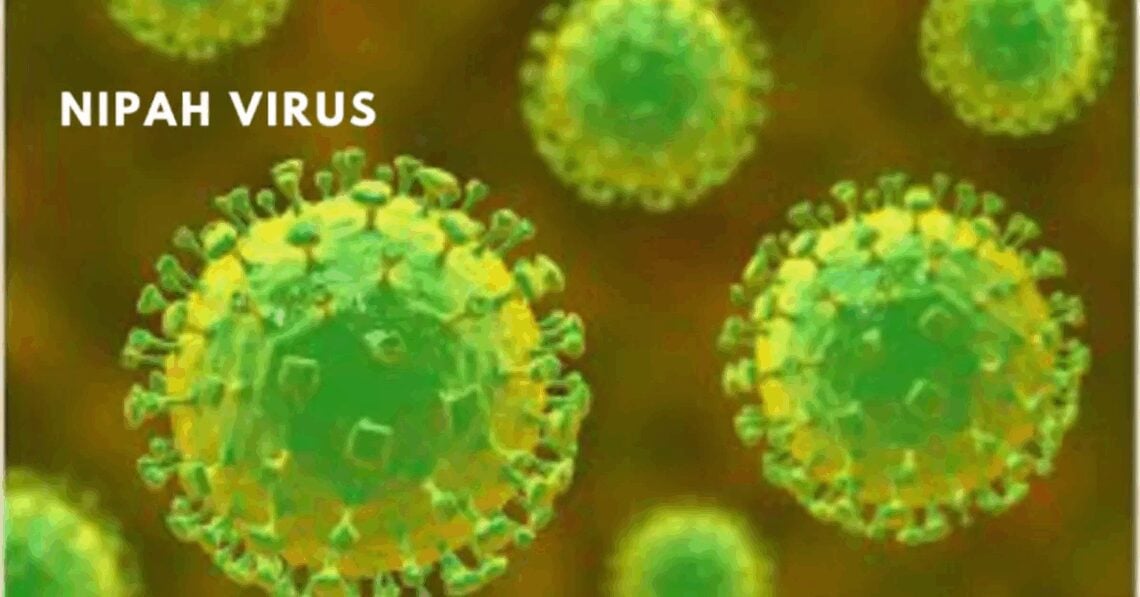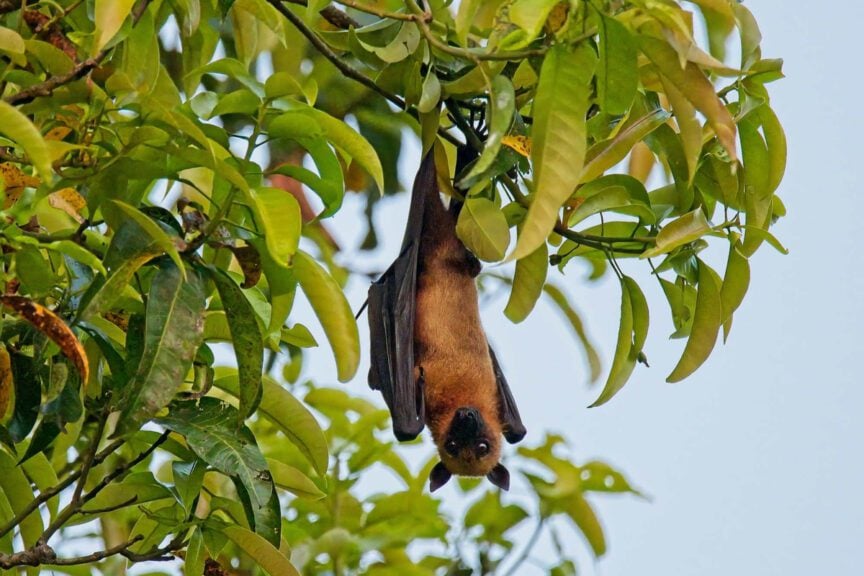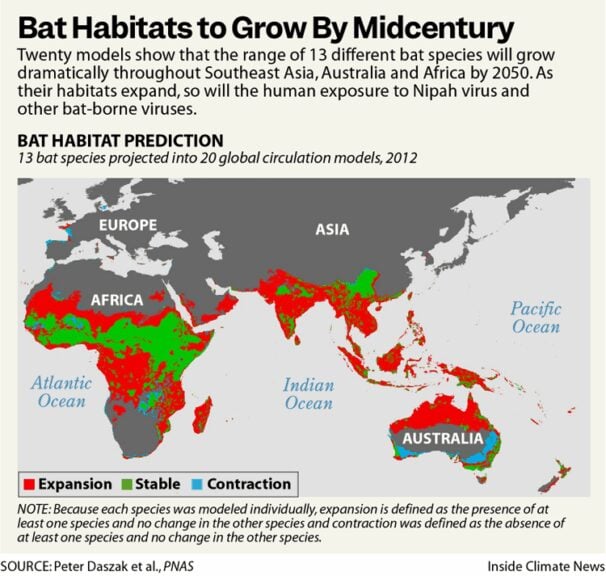
This article originally appeared on Inside Climate News, a nonprofit, non-partisan news organization that covers climate, energy and the environment. Sign up for their newsletter here.
Editor: Wasn’t there another virus carried by bats that infected humans? I can’t remember.. I hope we were successful at stopping the spread of that one…🤔 *sarcasm*
Climate change warmed the ocean and revived a bacteria that had gone away. It ended up causing massive die-offs of Starfish. Then, the urchin species that those starfish ate, exploded in population and munched through Kelp forests that were an important part of the ocean ecosystem.

If you mess with one link of a chain in nature/an ecosystem, the entire chain breaks. Climate change is not only wreaking havoc on nature and wildlife, it’s bringing back old viruses or facilitating their spread so that humans are now susceptible.
All of that is really bad. What’s worse is the fact that our government is ignoring the existence of global warming. Even worse: They are actively speeding it up. The EPA, under the Trump administration, released information claiming scientists have discovered that climate change isn’t as bad as people are saying.
PROPAGANDA.
Project 2025 instructed Trump to erase every instance of climate change terminology in the federal government. He did that. Project 2025 instructed Trump to shut down NOAA because it’s one of the “climate change agenda pushing” agencies in government. Huh?
Trump is getting rid of NOAA and FEMA at a time when global warming is causing more severe extreme weather events that are occurring more frequently. He cut funding to PBS and they shut down. PBS was the only way rural Americans could receive severe weather alerts and now they’re gone—right after the Texas floods.
Trump ended everything Biden had done to combat the climate crisis. He stopped all wind and solar projects and increased drilling for fossil fuels.

He even BROUGHT BACK COAL. The only people who can save the planet (and our children/grandchildren) are greedy morons who are willing to destroy the only home for the human species in order to enrich themselves further.
I talked about this in one of my climate change articles: If we don’t stop electing Democrats who pass legislation to deal with the climate crisis and attend conferences, collaborate with world leaders on the crisis, only to throw all progress in the trash and elect a Republican in the next presidential election, we will never make any progress.
We are taking 2 steps forward, then 3 steps back over and over and over. It’s insanity.
Unless we elect leaders who believe climate change is real and global warming is causing consequences that are affecting Americans right now (extreme weather events, melting glaciers and ice caps, warming ocean water disrupting ecosystems, etc.), we will never make any progress in the fight against the extinction of our species.
It doesn’t feel like that will ever happen when Americans are more tribal and polarized than ever before and conservative media is broadcasting lies and propaganda in ways we never thought possible. Republicans are currently in power, spreading disinformation and gaslighting their voters.
They’re dismantling the public education system in this country (and it wasn’t great to begin with) in order to keep people stupid. They are taking away healthcare and SNAP benefits, increasing inflation, and refusing to increase the federal minimum wage to keep people poor. The Keep them stupid and poor agenda is alive and well.
As they refuse to increase the minimum wage of $7.25/hour, Mike Johnson is at a press conference defending insider trading because people “still have to feed their families” when the salary of members of Congress has not increased since 2009. Mike Johnson and other Congressional leaders make $223,000/year. Rank and file members make $174,000/year, and they’re complaining about not getting a cost-of-living increase since 2009 when the last time they increased the federal minimum wage was in 2007, reaching $7.25 in July 2009!
Sorry about that ADD Moment/rant. I haven’t had one of those in a bit. Here’s the story you came here to read about the Nipah virus by Chad Small of Inside Climate News.
Inside Climate News
On May 3, 2018, a 26-year-old man living in the town of Perambra in the Indian state of Kerala went to the hospital complaining of fever and body aches. Muhammad Sabith’s symptoms did not seem serious enough for an overnight stay, so hospital staff sent him home after examining him.
Two days later, he died. By the end of the month, 16 other people in Perambra had succumbed to the same illness—Nipah virus, spread by fruit bats throughout South and Southeast Asia.
The virus, though deadly, is rare. In Bangladesh, where cultural practices bring people into contact with bats carrying the virus, less than 350 Nipah cases have been recorded since 2001, said Clifton McKee, an epidemiology researcher at Johns Hopkins University’s Bloomberg School of Public Health.
But this rarity doesn’t make it less dangerous. Depending on the outbreak, Nipah can have a fatality rate of up to 75 percent.
And just because the virus is rare now does not mean it always will be.
Climate change will likely expand the habitable range of the fruit bats that carry Nipah, putting more people in the virus’ crosshairs. Additionally, rising temperatures might push people and their livestock into regions where fruit bats are prevalent, another way to increase the potential of contracting Nipah.
The possibility of more exposures has prompted private foundations and pharmaceutical companies to invest millions of dollars researching how to combat the disease, with the first clinical trials of a vaccine to prevent infections set to begin later this year in Bangladesh.
Incidence of Nipah virus in humans has almost exclusively been confined to South Asia. Humans usually contract it when they—or their livestock—overlap with the Pteropus fruit bat, which is endemic to South and Southeast Asia.
Many human cases of Nipah virus come from consuming foods contaminated with bat saliva or urine, said Peter Daszak, president of Nature.Health.Global, a nonprofit that conducts scientific research related to conservation and global health.
In parts of Southeast Asia, this exposure is often through livestock. A 1998 Malaysian Nipah virus outbreak, which killed 105 people, was traced to pig farms.
“Pig farms were put right next to fruiting trees where bats lived,” Daszak said. “What we think happened is that the bats ate the fruit, spat bits out or urinated, and the pigs licked it and got infected. Then people got infected from the pigs.”
In Bangladesh, cultural customs are bringing people into closer contact with Nipah virus. Sap from date palm trees is considered a delicacy in the country, and drinking it is often how Bangladeshis end up catching the virus, McKee explained.
The sap is collected in pots that are usually left open, leaving them easily contaminated by bat saliva or urine.
Monitoring bat populations to find infected individuals that can spread the virus is virtually impossible, as the species doesn’t show any outward signs of infection.
“Bats have no reaction to it whatsoever,” McKee said.
Experimental studies suggest the fruit bat immune system tends to clear the virus incredibly quickly, usually within a few days. This makes finding the infection with surveillance of these fruit bats much more difficult.

Public health organizations identify Nipah in an area only after the first human is infected.
The virus often presents in humans similarly to meningococcal meningitis, with body aches, fever and some respiratory distress all common. But the most dangerous symptom is encephalitis, or inflammation of the brain, which results in headaches, disorientation and nausea. The swelling of the brain eventually sends patients into a coma, frequently ending in death.
“In Bangladesh, there have been outbreaks every year for as long as we’ve been looking, and probably 70 percent are fatal if you get infected,” Daszak said.
Given the poor prognosis of a Nipah diagnosis, low overall death tolls are only attributable to the disease’s rarity. “When we’ve sampled bats, we find that maybe one or two in every 1,000 bats carry the virus at any one time,” Daszak added. But climate change could bring a dangerous increase the incidence of Nipah.
A Warming Climate Spreads Bats and Diseases They Carry
Climate change is expected to change behaviors and distribution of Pteropus fruit bats, Rick Jarman, Nipah disease program lead at the Coalition for Epidemic Preparedness Innovations, wrote to Inside Climate News. This is “potentially expanding their range into new areas and increasing the risk of [Nipah] spillover events to humans and livestock.” Bats are predicted to be the species most able to successfully invade new habitats as the climate warms, spreading the diseases they carry to new regions and environments.
“New areas become available, like higher up the mountain” where conditions are cooler, Daszak said, “and then the vectors that allow diseases to spread shift and move with changing climate.”

Weather stress could also influence how frequently bats shed the virus. Johns Hopkins’ McKee highlighted evidence that fruit bats in Australia shed more Hendra virus, which is very similar to Nipah, when exposed to conditions like heatwaves. A warming climate with more heatwaves could lead to infected bats shedding more Nipah virus, although there is no evidence of that yet.
Climate-driven migrations of humans might also increase the rate of Nipah virus infections.
As certain parts of South and Southeast Asia get hotter, people migrating to more comfortable areas expose themselves to new pathogens. Migrants will usually move their livestock as well, providing yet another vector for Nipah infections.
“When you disrupt the environment in any way, there’s a strong chance you’re going to increase contact between hosts,” Daszak said.
Preventing Pandemic
Nipah’s baseline lethality makes any increase in prevalence of the virus dangerous. But while it is zoonotic, meaning it can pass between species, it is not easily transmitted between humans, making exponential spread among people less of a risk. Viruses can mutate, however, to increase the potential of human-to-human transmission.
“If a Nipah-like virus emerged that was as deadly as Nipah but also as contagious as Measles, this could be very worrying indeed,” Jarman wrote to Inside Climate News.
This story is funded by readers like you.
Our nonprofit newsroom provides award-winning climate coverage free of charge and advertising. We rely on donations from readers like you to keep going. Please donate now to support our work.
The analog to a future where Nipah passes from person to person is best reflected in the COVID-19 pandemic, which likely had zoonotic origins, numerous studies have indicated.
On top of killing millions of people, the COVID-19 pandemic ravaged the global economy. And its economic and mortality burdens were heaviest in developing nations, the same countries most threatened by Nipah, Daszak said.
In order to stave off a similar pandemic, the Coalition for Epidemic Preparedness Innovations has invested more than $100 million to help develop Nipah vaccines and antiviral therapies.
According to Jarman, one of the vaccines being developed in partnership with the University of Oxford is building on the same technology that was successfully deployed in the COVID-19 vaccine, developed by AstraZeneca in collaboration with Oxford.
The Nipah vaccine is slated to enter clinical trials on people in Bangladesh in the next few months.
While proactively developing a vaccine can be life-saving work, it is not without complications.
“Vaccines against zoonotic infections have a tougher road to pave for general acceptance and testing their effectiveness,” McKee explained.
In the example of a Nipah vaccine, cases of the virus are so rare that “your statistical power to detect vaccine effectiveness is really low,” McKee said.
With less than 350 Nipah cases in Bangladesh since 2001, for example, determining the effectiveness of a vaccine against it will be difficult compared to one for a virus that infects hundreds of thousands of people each year.
And even if the vaccine is effective, you still have to convince people to get it, he added. With a disease this uncommon, it’s unlikely that people will line up for vaccination, he said.
A non-vaccine case in point: From 2012 to 2014, researchers in Bangladesh launched the “only safe sap” initiative to convince date palm sap collectors to put protective skirts over the parts of trees with sap taps to keep bats out. But that initiative had only limited success, McKee noted.
“People are just like, ‘Nobody I know has ever had Nipah. I drink sap all the time and I’ve never gotten sick. This is a waste of time,’” he said.
And even if a Nipah vaccine works and people will get it, it will likely require government subsidies to reach rural areas where people are more often in contact with the fruit bat that carries the disease, McKee said.
With the vaccine still a few years from distribution if its trials are successful, Daszak believes the best investment in preventing zoonotic diseases is protecting the environment.
Human changes to the environment carry health risks that are not being measured, he said. “And eventually the cost [of the disease] is more than it would have been to prevent, and that’s the real irony and sadness about it.”

